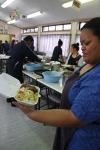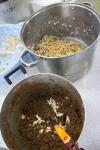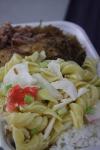Home-A College of many cultures
- Our team
- From an orchard and vineyard to a school
- Our school culture
- Our school song and haka
- Languages in our school
- Cultural fusion
- Taste sensations from Samoa and the Phillipines
- Arts and Culture Week
- National Independence of Samoa Day
- Discovering different types of cultural dances in Waitakere College
- Waitakere College Arts and Cultural Awards
- Our long-awaited school Marae
- 12,000 miles to New Zealand citizenship
- Europe to Australia to a life in the circus
- Massive state to tiny island to green New Zealand
- Afghanistan to New Zealand
- India to New Zealand
- Around the world
- Research process
- Learning outcomes
- References and acknowledgements
Taste sensations from Samoa and the Phillipines
Our school is a multi-cultural community filled with many different cultures and their own traditional foods. During Arts and Culture week we get a chance to taste the food from different cultures in our school. The main cultures of this presentation are the Islands of Samoa and the Philippines.
Samoa
Food is very important to the Samoan culture. In the islands, Samoans use what they call the umu to prepare most of their foods. The main foods that the people of Samoa eat is luau, talo, fish, fausi and pua'a (for special occasions).
Umu
Here in New Zealand, we use ovens to cook our food but in the island of Samoa, they use what they call the umu which is a traditional way of making their food. The umu is basically just above the ground with rocks laid out onto the ground. Though, not just any rocks, but lava rocks. When preparing a meal, you can put the uncooked food directly on the rocks or wrap it in banana leaves.
Luau
Luau is a special dish which is very easy to make. There is just a gathering of taro, coconut cream and onions. We add all the ingredients together and have it wrapped in a whole taro leaf. After this put together, you cook it in the umu. When cooked, you can either eat the whole dish, including the taro leaf or just eat what’s inside the taro leaf.
Talo (taro)
Taro is one of the popular island foods the Samoans eat. It’s so popular, that even the Samoans in New Zealand eat it (mostly on Sundays). There are so many taros in Samoa because nearly every family has a ma'umaga (taro plantation). A taro plantation in Samoa is mostly just a field filled with taro plants. Once in a while, people go there to collect taro for lunch or dinner of the day. The taro can be cooked in many different ways like baking it, boiling it and even including it in a different dish (like the luau). Taro is something the Samoan can never get enough of.
I'a (Fish)
Most of the time, the men of the family like to go out fishing. In New Zealand, we use things like a fishing rod and baits. Well, things are different in the islands. They pretty much use a spear and a very strong thick rubber band. They attach the rubber band to the end of the spear and stretch the rubber band. Once they let go, the spear will bounce off the rubber band, fly fast, depending on the strength used to pull the rubber band.
Fausi
Fausi is used as a dessert. It’s just cooked taro mixed with coconut cream that has been caramelized. It’s been made as a dessert because of the sweet taste of caramel.
Pua’a (Pig)
A cooked pig has a great taste to it. It’s simply just catch, cook and eat. The hardest thing about having pig for dinner is catching it first. Pigs are hard to catch because of their agility. So, the number one weapon for catching a pig is skill. You need to have the skills of agility and strength. First, you need to catch the pig with your bare hands and to catch it fast before it gets away. You then tie its legs together and then kill it whichever way you prefer it to be killed. This event mostly only happens on special occasions like a funeral, weddings or birthdays. I prefer this dish the best of them all.
Samoa has many other foods but there are just too many to list. Samoans never miss out on a meal because eating delicious meals makes their day. Food is very important because without Samoan food, there is no tradition and when there is no tradition and when there is no tradition, there is no Samoa.
‘’Samoa Mo Samoa’’
Camilla and Esther
Filipino Favourites
Pansit or Pancit
Pansit or pancit is the term for noodles in Filipino Cuisine. Noodles were introduced into the Philippines by the Chinese and have since been adopted into local cuisine. The word pansit came from the Chinese Hokkien Pian I Sit meaning convenient food. There are different kinds of noodles found in the supermarkets and that way they can be cooked at home. People can buy it cooked in a local restaurant or takeaways. That way it can be more “convenient”.
Buko Pandan or Coconut Pandan
Buko pandan or coconut pandan is a rich and tasty dessert that is similar to fruit salad and coconut salad. This dessert is distinct because it is enhanced by the aroma and flavour of the pandan leaves. Pandan is a tropical plant that grows abundantly in the Philippines and its blade-like leaves are used for cooking. It is prepared by boiling the pandan leaves in water until it's juice is released. The leaves are then removed and gelatine bars are added. The liquid mixture will turn into a jelly, which is then cut into cubes. After all that is done it has added by a juice of a young coconut. It is best served during the summer months or anytime there is a gathering like a birthday parties, feasts and during the holidays. My family always prepares this dessert during summer and in a gathering. And everyone likes it.
Crisanto
| Name | Ethnicity | Favourite food |
| Esther | Samoan, Indian | keke pua'a |
| Camilla | Samoan | pua'a (pig) |
| Rudri | Indian | curry |
| Alia | Indian | curry |
| Tafa | Samoan | sua fa'i |
| Tiegan John | Māori | hangi |
| Jahmaya | Māori | hangi |
| Cray | European | pancakes |
| Tatiana | Māori | butter chicken |
| Promise | Thai | noodles |
| Stefan | Tuavaluan | butter chicken |
| Jayden | Pakeha | butter chicken |
| Elijah | Samoan | chop suey |
| Bronte | European | pua'a |
| Devon | European | cheese |
| Laura | European | chicken |
| Michaela | European | pizza |
| Zane | Palagi | pizza |
| Renee | Palagi | butter chicken |
| Kelstyn | Māori | hangi and pizza |
| Krystal | Palagi | butter chicken |
| Telesia | Palagi | lamb |
| Crisanto | Filipino | pancit |
| Aswinan | Sri Lankan | chicken |
| Eddie | European New Zealander | bacon pancakes |





